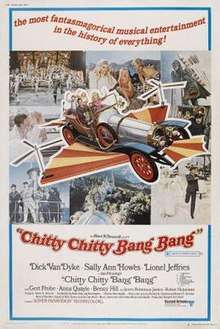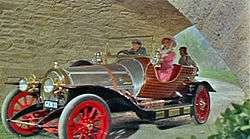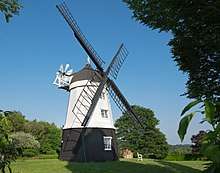Chitty Chitty Bang Bang
| Chitty Chitty Bang Bang | |
|---|---|
 Original cinema release poster | |
| Directed by | Ken Hughes |
| Produced by | Albert R. Broccoli |
| Screenplay by |
|
| Based on |
Chitty-Chitty-Bang-Bang by Ian Fleming |
| Starring | |
| Music by |
|
| Cinematography | Christopher Challis |
| Edited by | John Shirley |
Production company |
|
| Distributed by | United Artists Pictures Inc. |
Release date |
|
Running time | 145 minutes[1] |
| Country | United Kingdom |
| Language | English |
| Budget | $10 million[2] |
| Box office | $7.5 million (rentals)[3] |
Chitty Chitty Bang Bang is a 1968 British musical adventure fantasy film, directed by Ken Hughes and written by Roald Dahl and Hughes, loosely based on Ian Fleming's 1964 novel Chitty-Chitty-Bang-Bang: The Magical Car. The film stars Dick Van Dyke, Sally Ann Howes, Adrian Hall, Heather Ripley, Lionel Jeffries, James Robertson Justice, Robert Helpmann and Gert Fröbe.
The film was produced by Albert R. Broccoli, the regular co-producer of the James Bond series of films (also based on Ian Fleming novels). John Stears supervised the special effects. Irwin Kostal supervised and conducted the music, while the musical numbers, written by Richard M. and Robert B. Sherman of Mary Poppins, were staged by Marc Breaux and Dee Dee Wood. The song "Chitty Chitty Bang Bang" was nominated for an Academy Award.[4]
Plot
The story opens with a montage of European Grand Prix races in which one particular car appears to win every race it runs in from 1907 through 1908. However, in its final 1909 race, the car crashes and catches fire, ending its racing career. The car eventually ends up in an old garage in rural England, where two children, Jeremy and Jemima Potts, have grown fond of it. However, a man in the junkyard intends to buy the car from the garage owner, Mr. Coggins, for scrap. The children, who live with their father Caractacus Potts, an eccentric inventor, and the family's equally peculiar grandfather, implore their father to buy the car, but Caractacus cannot afford it. While playing truant from school, they meet Truly Scrumptious, a beautiful upper-class woman with her own motor car, who brings them home to report their truancy to their father. After she leaves, Caractacus promises the children that he will save the car, but is taken aback at the cost he has committed himself to. He looks for ways to raise money to avoid letting them down.
Later that evening, Potts discovers that the sweets produced by a machine he has invented can be played like a flute. He tries to sell the "Toot Sweets" to Truly's father, Lord Scrumptious, a major confectionery manufacturer. He is almost successful until the whistle attracts a pack of dogs who overrun the factory, resulting in Caractacus's proposition being rejected.
Caractacus next takes his automatic hair-cutting machine to a carnival to raise money, but his invention accidentally ruins the hair of a customer. Potts eludes the man by joining a song-and-dance act. He becomes the centre of the show and earns enough in tips to buy the car and rebuild it. They name the car "Chitty Chitty Bang Bang" for the unusual noise of its engine. In the first trip in the car, Caractacus, the children, and Truly picnic on the beach. Caractacus tells them a tale about nasty Baron Bomburst, the tyrant of fictional Vulgaria, who wants to steal Chitty Chitty Bang Bang.
As Potts tells his story, the quartet and the car are stranded by high tide and are attacked by pirates working for the Baron. All of a sudden, Chitty deploys huge flotation devices and transforms into a power boat, and they escape Bomburst's yacht and return to shore. The Baron sends two spies to capture the car, but they capture Lord Scrumptious, then Grandpa Potts, mistaking each for the car's creator. Caractacus, Truly, and the children see Grandpa being taken away by airship, and they give chase. When they accidentally drive off a cliff, Chitty sprouts wings and propellers and begins to fly. They follow the airship to Vulgaria and find a land without children; the Baroness Bomburst abhors them and imprisons any she finds. Grandpa has been ordered by the Baron to make another floating car, and he bluffs his abilities to avoid being executed. The Potts' party is hidden by the local Toymaker, who now works only for the childish Baron. Chitty is discovered and taken to the castle. While Caractacus and the toymaker search for Grandpa and Truly searches for food, the children are caught by the Baroness’ Child Catcher.
The Toymaker takes Truly and Caractacus to a grotto beneath the castle where the townspeople have been hiding their children. They concoct a scheme to free the children and the village from the Baron. The Toymaker sneaks them into the castle disguised as life-size dolls for the Baron's birthday. Caractacus snares the Baron, and the children swarm into the banquet hall, overcoming the Baron's palace guards and guests. In the ensuing chaos, the Baron, Baroness, and the evil Child Catcher are captured. The Potts family and Truly fly back to England. When they arrive home, Lord Scrumptious surprises Caractacus with an offer to buy the Toot Sweet as a canine confection. Caractacus, realising that he will be rich, rushes to tell Truly the news. They kiss, and Truly agrees to marry him. As they drive home, he acknowledges the importance of pragmatism, as the car takes off into the air again.
Cast

The cast includes:[5]
- Dick Van Dyke as Caractacus Potts
- Sally Ann Howes as Truly Scrumptious
- Adrian Hall as Jeremy Potts
- Heather Ripley as Jemima Potts
- Lionel Jeffries as Grandpa Bungie Potts
- Gert Fröbe as Baron Bomburst
- Anna Quayle as Baroness Bomburst
- Benny Hill as the Toymaker
- James Robertson Justice as Lord Scrumptious
- Robert Helpmann as the Child Catcher
- Barbara Windsor as Blonde
- Davy Kaye as Admiral
- Stanley Unwin as the Chancellor
- Peter Arne as the Captain of Bomburst's Army
- Desmond Llewelyn as Mr. Coggins
- Victor Maddern as Junkman
- Arthur Mullard as Big Man
- Max Wall as Inventor
- Gerald Campion as Minister
- Max Bacon as Orchestra Leader
- Alexander Doré as First Spy
- Bernard Spear as Second Spy
- Richard Wattis as Secretary at Sweet Factory (uncredited)
- Phil Collins as Vulgarian Child (scene cut)
The part of Truly Scrumptious had originally been offered to Julie Andrews, to reunite her with Van Dyke after their success in Mary Poppins. Andrews rejected the role specifically because she considered that the part was too close to the Poppins mould.[6] Instead, Sally Ann Howes was given the role. Dick Van Dyke was cast after he turned down the role of Fagin from another 1968 musical Oliver! (which ended up going to Ron Moody).
Production
Hughes said he did not enjoy making the film. "We took too long to make it," he said. "I sweated over it for about a year and really it was a only a children's film. I think such a thing should be made quickly and with enthusiasm. My enthusiasm ran out long before the end."[7]
The Caractacus Potts inventions in the film were created by Rowland Emett; by 1976, Time magazine, describing Emett's work, said no term other than "Fantasticator...could remotely convey the diverse genius of the perky, pink-cheeked Englishman whose pixilations, in cartoon, watercolor and clanking 3-D reality, range from the celebrated Far Tottering and Oyster Creek Railway to the demented thingamabobs that made the 1968 movie Chitty Chitty Bang Bang a minuscule classic."[8]
Six Chitty-Chitty Bang-Bang cars were created for the film, only one of which was fully functional. At a 1973 auction in Florida, one of them sold for $37,000, equal to $203,972 today.[9] The original "hero" car, in a condition described as fully functional and road-going, was offered at auction on 15 May 2011 by a California-based auction house.[10] The car sold for $805,000, less than the $1–2 million it was expected to reach.[11] It was purchased by New Zealand film director Sir Peter Jackson.[12]
Locations

| Feature in film | Location of filming |
|---|---|
| Scrumptious Sweet Co. factory (exterior) | Kempton Waterworks, Snakey Lane, Hanworth, Greater London, England.[13] This location now includes a steam museum open to the public. |
| Scrumptious Mansion | Heatherden Hall at Pinewood Studios in Iver Heath, Buckinghamshire, England[13] |
| Windmill/Cottage | Cobstone Windmill in Ibstone, near Turville, Buckinghamshire, England[13] |
| Duck Pond | Russell's Water, Oxfordshire, England[13] |
| Train scene | The Longmoor Military Railway, Hampshire, England |
| Beach | Cap Taillat, St. Tropez, France |
| River bridge where spies attempt to blow up Chitty | Iver Bridge, Iver, Buckinghamshire, England |
| Railway bridge where spies kidnap Lord Scrumptious | Ilmer Bridge, Ilmer, Buckinghamshire, England |
| White rock spires in the ocean and lighthouse | The Needles stacks, Isle of Wight, England |
| White cliffs | Beachy Head, East Sussex, England |
| Baron Bomburst's castle | Neuschwanstein Castle for the exterior.Bavaria, Germany |
| Vulgarian village | Rothenburg ob der Tauber, Bavaria, Germany |
Reception
Box office
The film was the tenth most popular at the US box office in 1969.[14]
Critical
Time began its review by saying the film is a "picture for the ages—the ages between five and twelve" and ended noting that "At a time when violence and sex are the dual sellers at the box office, Chitty Chitty Bang Bang looks better than it is simply because it's not not all all bad bad"; the film's "eleven songs have all the rich melodic variety of an automobile horn. Persistent syncopation and some breathless choreography partly redeem it, but most of the film's sporadic success is due to Director Ken Hughes's fantasy scenes, which make up in imagination what they lack in technical facility."[15]
The New York Times critic Renata Adler wrote, "in spite of the dreadful title, Chitty Chitty Bang Bang ... is a fast, dense, friendly children's musical, with something of the joys of singing together on a team bus on the way to a game"; Adler called the screenplay "remarkably good" and the film's "preoccupation with sweets and machinery seems ideal for children"; she ends her review on the same note as Time: "There is nothing coy, or stodgy or too frightening about the film; and this year, when it has seemed highly doubtful that children ought to go to the movies at all, Chitty Chitty Bang Bang sees to it that none of the audience's terrific eagerness to have a good time is betrayed or lost."[16]
Film critic Roger Ebert reviewed the film, writing: "Chitty Chitty Bang Bang contains about the best two-hour children's movie you could hope for, with a marvelous magical auto and lots of adventure and a nutty old grandpa and a mean Baron and some funny dances and a couple of [scary] moments."[17]
In 2008 film critic and historian Leonard Maltin considered the picture "one big Edsel, with totally forgettable score and some of the shoddiest special effects ever."[18] In 2013, Entertainment Weekly named Helpmann's depiction of the Child Catcher the 32nd of the "50 Most Vile Movie Villains."[19]
As of 5 July 2018, the film has a 67% approval rating on Rotten Tomatoes, based on 27 reviews with an average rating of 5.6/10.[20]
Accolades
The film was nominated for the American Film Institute's 2006 AFI's Greatest Movie Musicals list.[21]
Soundtrack
The original soundtrack album, as was typical of soundtrack albums, presented mostly songs with very few instrumental tracks. The songs were also edited, with specially recorded intros and outros and most instrumental portions removed, both because of time limitations of the vinyl LP and the belief that listeners would not be interested in listening to long instrumental dance portions during the songs.
The soundtrack has been released on CD four times, the first two releases using the original LP masters rather than going back to the original music masters to compile a more complete soundtrack album with underscoring and complete versions of songs. The 1997 Rykodisc release included several quick bits of dialogue from the film between some of the tracks and has gone out of circulation. On 24 February 2004, a few short months after MGM released the movie on a 2-Disc Special Edition DVD, Varèse Sarabande reissued a newly remastered soundtrack album without the dialogue tracks, restoring it to its original 1968 LP format.
In 2011, Kritzerland released the definitive soundtrack album, a 2-CD set featuring the Original Soundtrack Album plus bonus tracks, music from the Song and Picture Book Album on disc 1, and the Richard Sherman Demos, as well as six Playback Tracks (including a long version of international covers of the theme song). Inexplicably, this release was limited to only 1,000 units.[22]
In April 2013, Perseverance Records re-released the Kritzerland double CD set with expansive new liner notes by John Trujillo and a completely new designed booklet by Perseverance regular James Wingrove.
Home video releases
Chitty Chitty Bang Bang was released numerous times in the VHS format. In 1998 the film saw its first DVD release. The year 2003 brought a two-disc "Special Edition" release. On 2 November 2010, 20th Century Fox released a two-disc Blu-ray and DVD combination set featuring the extras from the 2003 release as well as new features. The 1993 LaserDisc release by MGM/UA Home Video was the first home video release with the proper 2.20:1 Super Panavision 70 aspect ratio.
Adaptations
Novelisation of film
The film did not follow Fleming's novel closely. A separate novelisation of the film was published at the time of the film's release. It basically followed the film's story but with some differences of tone and emphasis, e.g. it mentioned that Caractacus Potts had had difficulty coping after the death of his wife, and it made it clearer that the sequences including Baron Bomburst were extended fantasy sequences. It was written by John Burke.[23]
Comic book adaption
- Gold Key: Chitty Chitty Bang Bang. Gold Key Comics. February 1969. [24]
References
- ↑ "CHITTY CHITTY BANG BANG (U)". British Board of Film Classification. 18 October 1968. Retrieved 27 August 2016.
- ↑ "Chitty Chitty Bang Bang (1968)". FlickFacts. Archived from the original on 18 August 2013. Retrieved 5 July 2018.
- ↑ "Big Rental Films of 1969". Variety. Penske Business Media. 7 January 1970. p. 15. Retrieved 5 July 2018.
- ↑ "About Ian Fleming". Ian Fleming Centenary. Archived from the original on 6 March 2012. Retrieved 9 February 2012.
- ↑ "Chitty Chitty Bang Bang". Metro-Goldwyn-Mayer Studios. Retrieved 5 July 2018.
- ↑ Stirling, Richard (2009). Julie Andrews: An Intimate Biography. New York: St. Martin's Press. ISBN 9780312380250.
- ↑ Cromwell knocked about a bit The Guardian 16 July 1970: 8.
- ↑ "Modern Living: The Gothic-Kinetic Merlin of Wild Goose Cottage". Time. 1 November 1976. Retrieved 5 November 2010.
- ↑ "Modern Living: Crazy-Car Craze". Time. 30 April 1973. Retrieved 5 November 2010.
- ↑ Profiles (25 April 2011). "Chitty Chitty Bang Bang to be Sold at Auction" (Press release). Profiles In History. Retrieved 5 July 2018.
- ↑ Lewis, Andy (16 May 2011). "'Chitty Chitty Bang Bang'Car Undersells at Auction". The Hollywood Reporter. Prometheus Global Media. Retrieved 16 April 2014.
- ↑ Cooke, Michelle (22 October 2011). "Jackson picks up Chitty Chitty Bang Bang". The Dominion Post. Stuff. Retrieved 25 March 2018.
- 1 2 3 4 "Where was 'Chitty Chitty Bang Bang' filmed?". British Film Locations. Retrieved 5 July 2018.
- ↑ "The World's Top Twenty Films". The Sunday Times. 27 September 1970. p. 27 – via The Sunday Times Digital Archive.
- ↑ "New Movies: Chug-Chug, Mug-Mug". Time. 27 December 1968. Retrieved 5 November 2010.
- ↑ Adler, Renata (19 December 1968). "'Chitty Chitty Bang Bang': Fast, Friendly Musical for Children Bows". The New York Times. The New York Times Company. Retrieved 5 November 2010.
- ↑ Ebert, Roger (24 December 1968). "Chitty Chitty Bang Bang". RogerEbert.com. Ebert Digital LLC. Retrieved 5 July 2018.
- ↑ Maltin, Leonard (2008). Leonard Maltin's 2009 Movie Guide. New York: Plume. p. 241. ISBN 9780452289789.
- ↑ EW Staff (17 May 2013). "50 Most Vile Movie Villains". Entertainment Weekly. Time. Retrieved 5 July 2018.
- ↑ "Chitty Chitty Bang Bang (1968)". Rotten Tomatoes. Fandango Media. Retrieved 5 July 2018.
- ↑ "Official Ballot" (PDF). AFI's Greatest Movie Musicals. American Film Institute. 3 September 2006. Retrieved 25 March 2018.
- ↑ "Chitty Chitty Bang Bang". Kritzerland. Retrieved 25 March 2018.
- ↑ Burke, John Frederick; Fleming, Ian (1968). "Chitty Chitty Bang Bang: The Story of the Film". Pan Books. ISBN 9780330022071. Retrieved 20 April 2012.
- ↑ "Gold Key: Chitty Chitty Bang Bang". Grand Comics Database.
External links
| Wikimedia Commons has media related to Chitty Chitty Bang Bang (film). |
| Wikiquote has quotations related to: Chitty Chitty Bang Bang |